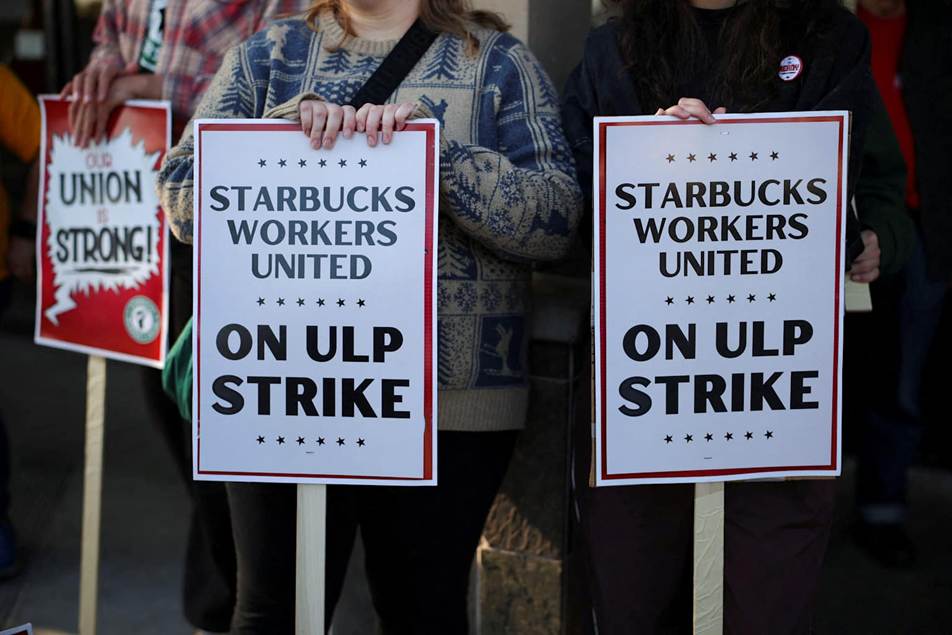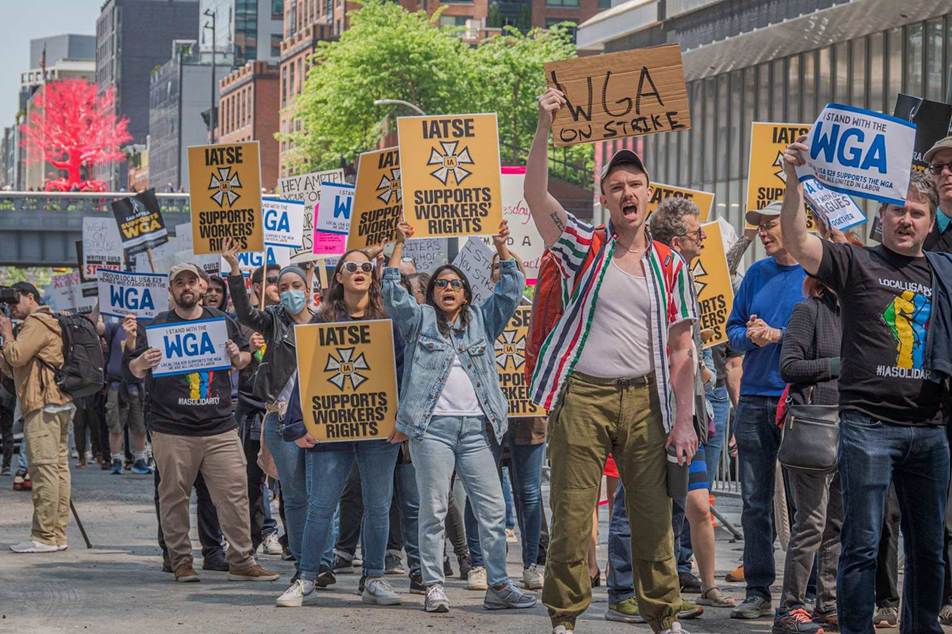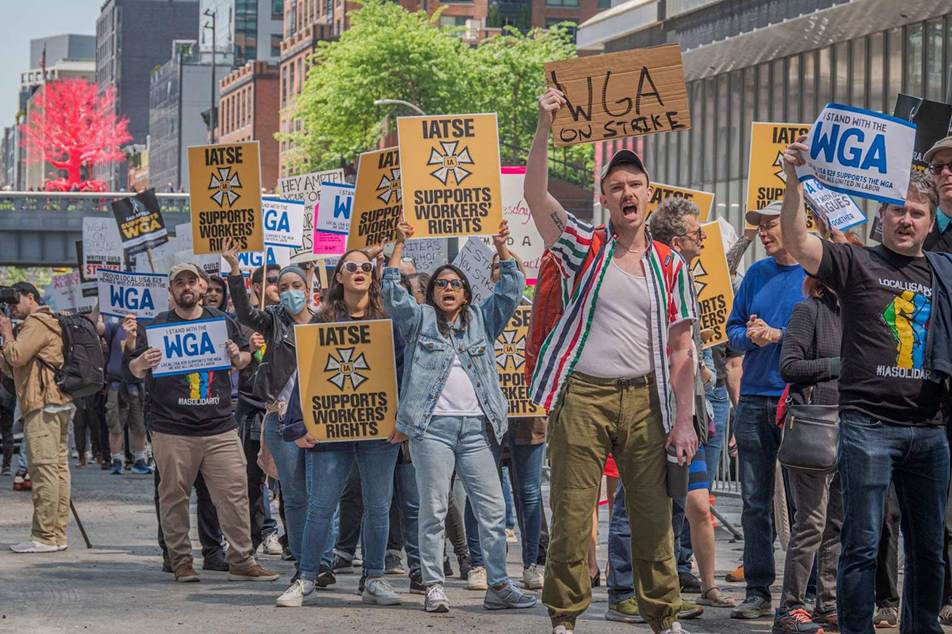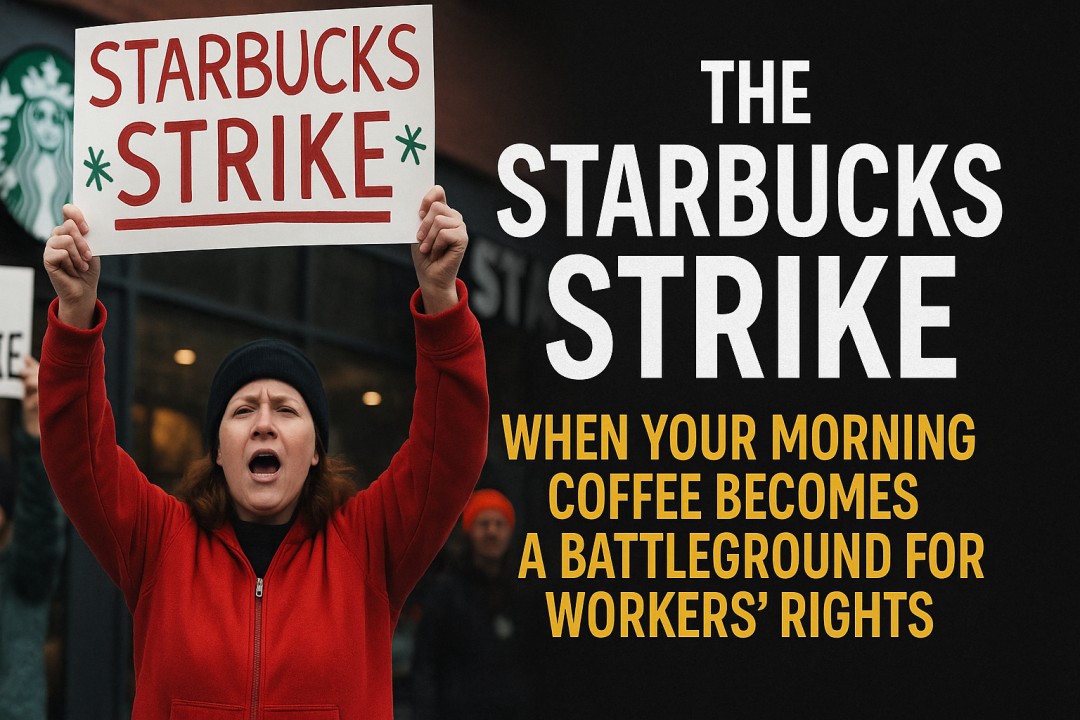The Starbucks Strike: When Your Morning Coffee Becomes a Battleground for Workers’ Rights
As Americans across the country prepared to kick off their holiday shopping season in November 2024, thousands of Starbucks workers walked off the job in what has become one of the most significant labor actions in the coffee giant’s history. For many of us who frequent Starbucks for our daily caffeine fix, this strike represents far more than an inconvenience—it’s a mirror reflecting deeper issues about income inequality, corporate power, and the American Dream itself.[1][2][3]
On November 13, 2024, unionized baristas at 65 stores across more than 40 U.S. cities launched an open-ended strike that union organizers dubbed the “Red Cup Rebellion”. The timing was strategic: Red Cup Day is traditionally one of Starbucks’ busiest and most profitable days of the year, when customers line up for free reusable holiday cups with their specialty beverage purchases. What was meant to be a celebration of the holiday season instead became a nationwide protest against what workers describe as poverty wages, chronic understaffing, and unprecedented union-busting.[2][3][4][5][6][7]

Starbucks workers united on ULP strike at a picket line in the US demonstrating union strength.
The Workers Behind Your Morning Latte
To understand this strike, we need to understand who makes our coffee. The vast majority of Starbucks’ approximately 200,000 U.S. employees are hourly baristas—young people working their way through college, single parents trying to make ends meet, and older workers seeking a “progressive” employer that once promised comprehensive benefits and decent wages.[4][8]
In most states, Starbucks baristas start at just $15 per hour. While Starbucks touts an average wage of $17 per hour when you factor in all employees and tenure, the reality for many workers is far grimmer. According to MIT’s Living Wage Calculator, $15 per hour isn’t enough to afford the cost of living in any U.S. state when working 40 hours per week. But here’s the cruel twist: most Starbucks workers don’t even get 40 hours. Union members report that the majority of baristas receive fewer than 20 hours per week—just under the threshold needed to qualify for the company’s vaunted health insurance benefits.[2][5][8][9][10][11][12][13]
Let that sink in for a moment. You need to work at least 20 hours per week to qualify for health insurance at Starbucks, but many workers struggle to get scheduled for even that minimum. Michelle Eisen, a 15-year Starbucks veteran and union spokesperson from Buffalo, New York, put it bluntly: “Too many of us rely on SNAP or Medicaid just to get by, and most baristas still don’t earn a livable wage”.[5][12][14]
The math is sobering. Working 19 hours per week at $15 per hour yields an annual income of approximately $14,860—well below the federal poverty line for a single-person household and barely enough to cover rent in most American cities. For context, a single adult needs to earn between $38 and $56 per hour just to live comfortably in most U.S. states, depending on location.[15][11][5]
From Coffee Shop to Union Hall: The Movement’s Origins
The current strike didn’t materialize overnight. It’s the culmination of a grassroots organizing effort that began in Buffalo, New York, in 2021. In a story that would have seemed impossible just a few years ago, workers at a single Starbucks store voted to unionize in December 2021, becoming the first successful union election at a company-owned Starbucks in the United States.[3][4][5][16]
What happened next was nothing short of remarkable. The Buffalo victory sparked a wildfire of organizing across the country. Within three years, workers at more than 650 stores voted to join Starbucks Workers United, representing approximately 12,000 baristas across 45 states. It became one of the most successful union campaigns in a generation, inspiring workers at other major corporations like Amazon and Apple to launch their own organizing drives.[4][17][18][19][20][3]
But winning a union election and securing a contract are two very different things. Under U.S. labor law, employers are not required to reach an agreement with their workers’ unions within any specific timeframe—or at all. This loophole has allowed companies to drag their feet on negotiations indefinitely, and Starbucks has exploited it to the fullest extent.[21]

Workers demonstrating support for labor union rights and strikes, including IATSE and WGA unions, in a city protest.
The Three-Year Wait for a Contract
Despite winning their first election in December 2021, Starbucks workers still don’t have a contract as of November 2024. National framework bargaining between Starbucks and Workers United didn’t even begin until April 2024—more than two years after the first store unionized. And even then, negotiations quickly stalled.[3][17][16][22]
The union’s demands are straightforward and, by most measures, modest:[2][5][3]
1. Higher wages: Workers are asking for wage increases that reflect the actual cost of living in their communities. While Starbucks claims to offer competitive pay, workers point out that $15 per hour in 2024 has far less purchasing power than it did when the Fight for $15 movement began in 2012.[8]
2. Better staffing and more hours: Chronic understaffing has become endemic at Starbucks stores, leading to longer wait times for customers and overwhelming stress for workers. Baristas report being responsible for multiple positions simultaneously—taking orders, making drinks, cleaning, and handling food preparation—while management cuts labor hours to boost profits.[4][5][23]
3. Resolution of unfair labor practices: This is perhaps the most damning issue. Workers United has filed more than 1,000 unfair labor practice (ULP) charges against Starbucks with the National Labor Relations Board, with over 700 charges still unresolved. These charges include illegal firings of union organizers, surveillance of workers, threatening to close unionized stores, and refusing to bargain in good faith.[5][17][3][4]
In April 2024, union delegates overwhelmingly rejected Starbucks’ contract proposal because it offered zero wage increases in the first year and failed to address understaffing. Yes, you read that correctly: after more than two years of negotiations, Starbucks offered its unionized workers exactly nothing in year one.[17][16][3][4]
The Company That Cried “Unreasonable”
Starbucks executives have consistently characterized workers’ demands as “unreasonable”. CEO Brian Niccol, who took over in September 2024, told CBS Mornings that “what their requests to date have been, has been unreasonable” and claimed Starbucks already offers “the best benefits” and “the best wages” in the industry.[2][24]
Let’s examine that claim through the lens of another number: $96 million. That’s how much Niccol earned in his first four months on the job—from September to December 2024. His total annual compensation package is estimated at $113 million, making him one of the highest-paid CEOs in America. This eclipsed even the compensation of tech titans like Apple’s Tim Cook and Google’s Sundar Pichai, who each earned around $75 million for an entire year.[25][26][27][28][29]
Breaking down Niccol’s compensation reveals the stark reality of corporate America’s priorities. About 94% of his pay came from stock awards, he received a $5 million signing bonus after just one month, and Starbucks covers his use of a company jet to commute from his home in Southern California to Seattle—a 1,600-kilometer journey that costs the company tens of thousands of dollars. The company even pays over $143,000 in housing costs and tax payments for him.[26][27][28][25]
Now consider this: Niccol earned approximately $96 million in four months, while the average Starbucks barista made about $14,674 for an entire year. That means Niccol earned roughly 6,540 times more than the average barista in the same time period. According to Starbucks Workers United, the cost of settling a fair contract with all 12,000 unionized workers would be less than a single day of company sales—or about four months of Niccol’s 2024 compensation.[3][17][15][16][23]
When workers say the company’s priorities are skewed, this is what they mean.
America’s Most Prolific Labor Law Violator
Perhaps the most disturbing aspect of this story is Starbucks’ systematic violation of U.S. labor law. The National Labor Relations Board—the federal agency responsible for protecting workers’ rights—has found Starbucks guilty of more than 500 labor law violations, making it the worst corporate offender in modern American history.[5][17][30]
What do these violations look like in practice? Administrative law judges have found that Starbucks has:
- Illegally fired and disciplined union organizers and supporters[4][30][31]
- Withheld wages and benefits from unionized stores[30][5]
- Threatened to close stores that vote to unionize[17][5]
- Conducted illegal surveillance of employees engaged in organizing activities[5][30]
- Refused to bargain in good faith with the union[16][17][30]
- Unilaterally changed working conditions without negotiating with the union[30][16]
In one particularly egregious case, an administrative law judge concluded that Starbucks “has engaged in a scorched earth campaign and pattern of misconduct in response to union organizing at its stores across the United States” and noted that “despite several Board orders and dozens of ALJ decisions, Respondent’s behavior continues unabated”.[17]
Former Starbucks CEO Howard Schultz was personally found to have violated labor law when he told a union organizer at a 2022 meeting: “If you’re not happy at Starbucks, you can go work for another company”. The NLRB ruled this statement was an unlawful threat that implied workers could be fired for union activity.[32]
The scale of Starbucks’ union-busting has been staggering. According to the Strategic Organizing Center, the company spent more than $240 million on union-busting efforts through February 2024. This includes legal fees, payments to anti-union consultants, productivity losses from store closures, and mandatory “captive audience meetings” where managers pressure workers to vote against unionization.[5]
The Red Cup Rebellion: Strategic Timing and Escalation
When Starbucks Workers United called for a strike vote in October and early November 2024, the response was overwhelming: 92% of participating workers voted to authorize an open-ended work stoppage. The union carefully chose November 13—Red Cup Day—as the strike’s launch date.[2][3][5][17]
Red Cup Day isn’t just another promotional event; it’s a cultural phenomenon that Starbucks has cultivated for years. The day typically sees foot traffic increase by 40-50% compared to normal Thursdays, and in 2024, it was reportedly the company’s biggest sales day ever in North America. By striking on this crucial day, workers aimed to hit Starbucks where it hurts most: its bottom line during the critical holiday season.[5][33][17][6][7][34][35]
The strike began with over 1,000 workers walking off the job at 65 stores across more than 40 cities, including major rallies in New York, Philadelphia, Chicago, Columbus, and Anaheim. Union leaders made clear that this was just the beginning. With no set end date and workers at all 550+ unionized stores prepared to join, organizers pledged to make this “the largest and longest strike in company history” if Starbucks refused to bargain fairly.[3][17][5]
“If Starbucks keeps stonewalling a fair contract and refusing to end union-busting, they’ll see their business grind to a halt,” said Michelle Eisen. “No contract, no coffee is more than a tagline—it’s a pledge to interrupt Starbucks’ operations and profits until a fair union contract and an end to unfair labor practices are won.”[17][2][5]
The union also called on customers to honor picket lines and boycott Starbucks for the duration of the strike. The campaign gained high-profile support, including from Zohran Mamdani, New York City’s incoming mayor, who publicly urged his supporters to avoid Starbucks until the strike ended.[4][33][36][5]
Why This Matters to Every American
If you’ve never been a barista, never worked in food service, and never thought much about labor unions, you might wonder why this strike should matter to you. The answer lies in what this conflict represents about the American economy in 2024.
Income inequality has reached historic levels. The top 1% of American households now hold 30.5% of the country’s wealth, while the bottom 50% hold just 2.5%. The wealth gap between the richest and poorest Americans more than doubled between 1989 and 2016, and it continues to grow. For every dollar of income increase an average household receives, wealthy households generate five times more wealth.[37][38][39]
The labor movement is experiencing a resurgence. Public support for unions has reached its highest level in decades, with 68-71% of Americans approving of labor unions—a level not seen since the 1960s. This shift reflects growing recognition that without collective bargaining power, workers have little ability to demand fair wages and working conditions in an economy dominated by massive corporations.[40][41][42][43]
Corporate consolidation gives companies unprecedented power over workers. When a handful of companies dominate entire industries, workers have fewer alternative employers and less leverage to negotiate. Starbucks operates more than 17,000 stores across North America. When you’re a barista, your realistic employment options are limited—especially when most food service jobs offer similar low wages and poor conditions.[10]
The regulatory system designed to protect workers is under attack. The Trump administration has systematically weakened the National Labor Relations Board, firing key members and leaving the agency without a quorum to hear cases. This means that even when companies blatantly violate labor law, workers may have no effective recourse. The NLRB is currently unable to issue decisions, set precedent, or take formal action on unfair labor practice charges—effectively giving employers free rein to violate workers’ rights.[44][45][46]
What happens at Starbucks will influence labor relations across America. When workers at one of the country’s most visible companies successfully organize and win a fair contract, it sends a powerful message that collective action works. Conversely, if Starbucks succeeds in stonewalling negotiations indefinitely, it provides a roadmap for other corporations to neutralize unions even after workers vote to organize.
The Broader Labor Awakening
The Starbucks campaign is part of a larger labor awakening sweeping across America. In 2022, workers at an Amazon warehouse on Staten Island shocked the business world by voting to form the first Amazon union in U.S. history—the Amazon Labor Union. The New York Times called it “one of the biggest victories for organized labor in a generation,” while Jacobin magazine described it as “the most important labor victory in the United States since the 1930s”.[18][19][20]
Like Starbucks Workers United, the Amazon Labor Union (ALU) organized through grassroots, worker-led efforts rather than relying on traditional union structures. They spent months talking to coworkers during shift changes, hosting cookouts outside the warehouse, and building solidarity one conversation at a time. And like Starbucks workers, they’ve faced relentless opposition from their employer, which has refused to recognize the union and bargain in good faith.[19][21][47]
In June 2024, the ALU voted to affiliate with the Teamsters, one of America’s largest and most powerful unions, giving the Amazon workers access to greater resources and institutional support. By late 2024, Teamsters launched strikes at Amazon facilities in multiple states, declaring that “thousands” of Amazon workers had joined the union.[48][47][19]
This wave of organizing extends beyond retail and warehouse workers. The Writers Guild of America and Screen Actors Guild went on strike in 2023, paralyzing Hollywood production for months. United Auto Workers secured major contract victories after strikes against the Big Three automakers. Teachers, nurses, and university workers have all launched successful organizing campaigns and strikes.[43][49]

Workers demonstrating support for labor union rights and strikes, including IATSE and WGA unions, in a city protest.
What unites these movements is a simple recognition: the American economy isn’t working for working people. Wages have stagnated for decades while costs of housing, healthcare, and education have skyrocketed. The COVID-19 pandemic laid bare how many “essential workers” were treated as disposable despite risking their lives to keep the economy running. And as corporate profits and executive compensation reached record highs, workers increasingly concluded that only collective action could secure a fair share of the wealth they create.[4][8]
The American Dream on Minimum Wage
There’s a particular irony in Starbucks becoming a flashpoint for labor organizing. For years, the company cultivated an image as a progressive employer—offering health insurance to part-time workers, supporting LGBTQ rights, and referring to employees as “partners” rather than workers. This branding attracted young people who wanted to work for a company aligned with their values.[4][8]
But workers report that this progressive facade has steadily eroded over the years. During the pandemic, Starbucks implemented rapidly changing policies without worker input, all while recording record profits. The company cut hours and staffing even as customer demands increased. Workers who once felt valued increasingly felt disposable.[8][4]
“The progressive environment that attracted them to the company has diminished over the years—if it ever existed within the company in the first place—and they’ve been increasingly treated as disposable,” reported one analysis of worker testimonies.[8]
This disillusionment reflects a broader reckoning with corporate America’s promises. For decades, workers were told that if they worked hard, got an education, and played by the rules, they could achieve financial security and upward mobility—the American Dream. But for millions of Americans, that promise has proven hollow.
Consider what it takes to simply live—not thrive, but survive—in 2024 America. In Massachusetts, a single adult needs to earn at least $55.78 per hour to cover basic needs, save for emergencies, and have a modest quality of life. In California, it’s $54.64 per hour. Even in the cheapest states like West Virginia, you need $37.88 per hour. Yet the federal minimum wage remains stuck at $7.25 per hour—unchanged since 2009.[50][11][51]
The $15 per hour that activists fought for in 2012 would be worth only about $12 today after accounting for inflation. Meanwhile, the Fight for $15 has largely stalled, with activists now calling for $18 or more as the new baseline. But even $18 per hour—$37,440 per year for full-time work—isn’t enough to live comfortably in most of America when you factor in rent, food, transportation, healthcare, and other basic expenses.[11][8]
Facing an Uncertain Future
As the Starbucks strike entered its second week in November 2024, both sides remained at an impasse. Starbucks claimed that the strike affected less than 1% of its stores and that 99.9% of locations remained open. The company continued to characterize the union as representing a small minority of workers and expressed disappointment that Workers United chose to strike rather than return to negotiations.[24][33][36][52][53][54][55]
Union leaders told a different story. They noted that Starbucks had closed hundreds of stores across the country with little notice, including 59 unionized locations. They pointed out that the company refused to put forth serious economic proposals during bargaining sessions. And they emphasized that workers didn’t want to strike—they were forced to because Starbucks left them no alternative path to secure fair wages and working conditions.[4][33][17][16][22][23]
More than 100 members of Congress, including Senator Bernie Sanders and Representative Pramila Jayapal, sent letters to CEO Brian Niccol demanding that Starbucks stop union-busting and negotiate fairly. “Despite that extravagant spending on executives and shareholders, Starbucks refuses to reach an agreement with its own workers even though you are less than one average day’s sales apart from a contract,” the lawmakers wrote.[5][17][23]
The path forward remains uncertain. With the Trump administration having gutted the NLRB’s enforcement capabilities, Starbucks faces little meaningful pressure to change course. The agency cannot currently issue decisions or enforce labor law due to lacking a quorum. This emboldens companies to violate workers’ rights with impunity, knowing that legal consequences are unlikely.[44][45][46]
Yet workers are not backing down. The strike continues, with union members vowing to escalate actions if necessary. They’ve built a movement that extends far beyond Starbucks, connecting with community organizations, other unions, and social justice groups that see this struggle as part of a larger fight for economic justice.[3][17][52][23][5]
What You Can Do
For the millions of Americans who regularly patronize Starbucks, this strike presents a choice. You can cross picket lines and get your coffee as usual, or you can honor workers’ requests and take your business elsewhere until a fair contract is signed.
If you support the workers, here’s what you can do:
1. Don’t cross picket lines. If there’s a Starbucks on strike in your community, go to a different coffee shop. Take a picture of yourself at a local café and share it on social media with #NoContractNoCoffee to show solidarity.[4][5][36]
2. Contact Starbucks leadership. Let CEO Brian Niccol know that you want to see the company bargain fairly with its workers. You can find contact information on Starbucks’ corporate website.
3. Support local, independent coffee shops. These businesses often pay better wages, provide more stable schedules, and contribute more to local economies than corporate chains.
4. Talk about the strike. Share articles and information about the strike on social media. Many Americans have no idea this labor action is happening. Raising awareness is crucial.
5. Support other labor struggles. The Starbucks strike is part of a broader movement. Support unions in your community, whether they’re teachers, nurses, autoworkers, or warehouse employees. Attend rallies, sign petitions, and vote for candidates who support workers’ rights.
A Defining Moment
The Starbucks strike is about more than coffee. It’s about whether America will continue down a path of extreme inequality where CEOs earn thousands of times more than the workers who create value for their companies, or whether we’ll build an economy that provides dignity and security for everyone who works.
It’s about whether corporations will be held accountable when they systematically violate labor law, or whether they’ll face no consequences for union-busting and wage theft.
It’s about whether the next generation of workers will accept poverty wages and precarious employment as inevitable, or whether they’ll organize and fight for something better.
The baristas walking picket lines outside Starbucks stores aren’t asking for luxury. They’re asking for what previous generations of Americans took for granted: a fair day’s pay for a fair day’s work, enough hours to qualify for health insurance, and the basic dignity of having their employer bargain with them in good faith.
Their struggle is our struggle. Because if workers at one of America’s most visible companies can’t win a fair contract after three years of organizing, negotiating, and striking, what hope do any of us have for economic justice?
The coffee will taste different once you know the truth about who makes it and what they’re fighting for. The question is: what will you do with that knowledge?
- https://www.businessinsider.com/pro-labor-flyers-starbucks-corporate-headquarters-unionized-barista-strike-2025-11
- https://www.cbsnews.com/news/starbucks-union-workers-strike-contract-deal/
- https://sbworkersunited.org/our-strike/
- https://inthesetimes.com/article/starbucks-workers-united-union-red-cup-rebellion-strike-picket
- https://inthesetimes.com/article/starbucks-workers-united-strike-unfair-labor-boycott
- https://www.placer.ai/anchor/articles/starbucks-red-cup-day-makes-a-comeback
- https://www.convenience.org/Media/Daily/2024/December/4/3-Starbucks-Draws-Customers-With-Red-Cup_Research
- https://truthout.org/articles/data-reveals-63-percent-of-hourly-starbucks-workers-make-under-15-an-hour/
- https://www.restaurantdive.com/news/starbucks-will-raise-hourly-wage-floor-to-15-a-year-ahead-of-schedule/609063/
- https://www.reuters.com/markets/us/starbucks-raise-wage-us-store-workers-by-least-3-2024-2023-11-06/
- https://smartasset.com/data-studies/state-salary-living-comfortably-2024
- https://coverageguru.com/posts/starbucks-health-insurance-plans
- https://www.starbucks-partnerhour.com/benefits-hours/
- https://www.starbucksbenefits.com/en/home-ca-en/resources/benefits-eligibility/
- https://www.investopedia.com/starbucks-faces-scrutiny-as-ceo-s-pay-is-6-666-times-that-of-the-median-barista-11807782
- https://sbworkersunited.org/bargaining-timeline/
- https://sbworkersunited.org/union-starbucks-baristas-launch-unfair-labor-practice-strike-in-40-cities-nationwide/
- https://www.amazonlaborunion.org
- https://en.wikipedia.org/wiki/Amazon_Labor_Union
- https://clje.law.harvard.edu/events/the-rebirth-of-americas-labor-movement-amazon-labor-union-alu-and-the-future/
- https://www.thenation.com/article/culture/amazon-union-documentary/
- https://www.restaurantdive.com/news/starbucks-workers-united-largest-open-ended-red-cup-strike/805399/
- https://prospect.org/2025/11/13/starbucks-workers-tell-bosses-no-contract-no-coffee/
- https://www.ragan.com/the-week-in-comms-starbucks-paramount-manager-ai/
- https://www.news18.com/business/this-ceo-earned-nearly-100-million-in-4-months-surpassing-tim-cook-sundar-pichais-annual-pay-9201307.html
- https://www.hindustantimes.com/business/starbucks-ceo-brian-niccol-earned-96-million-for-four-months-of-work-in-2024-101737770048353.html
- https://finance.yahoo.com/news/starbucks-ceo-brian-niccol-awarded-032442455.html
- https://indianexpress.com/article/world/starbucks-ceo-brian-niccol-2024-salary-96-million-9800547/
- https://economictimes.com/tech/technology/96-million-payday-for-starbucks-ceo-brian-niccol-beats-packages-of-tim-cook-sundar-pichai/articleshow/117553164.cms
- https://www.nlrbedge.com/p/02252025-a-bunch-of-starbucks-unfair
- https://digitalcommons.law.villanova.edu/cgi/viewcontent.cgi?article=2091&context=thirdcircuit_2024
- https://www.latimes.com/business/story/2024-10-04/nlrb-finds-former-starbucks-ceo-violated-labor-law-in-handling-long-beach-employee-unionization-questions
- https://economictimes.com/news/international/global-trends/us-news-no-contract-no-coffee-why-zohran-mamdani-is-urging-everyone-to-boycott-starbucks-all-you-need-to-know/articleshow/125362093.cms
- https://www.restaurantdive.com/news/starbucks-red-cup-day-holiday-launch-sales-traffic-up/805581/
- https://observer.com/2025/11/starbucks-red-cup-day-ceo-turnaround/
- https://www.ndtv.com/world-news/new-york-city-mayor-elect-zohran-mamdani-calls-for-starbucks-boycott-amid-nationwide-strike-9640338
- https://www.pewresearch.org/social-trends/2020/01/09/trends-in-income-and-wealth-inequality/
- https://en.wikipedia.org/wiki/Wealth_inequality_in_the_United_States
- https://www.statista.com/statistics/203961/wealth-distribution-for-the-us/
- https://news.gallup.com/poll/694472/labor-union-approval-relatively-steady.aspx
- https://www.afge.org/article/new-gallup-poll-70-of-americans-approve-of-labor-unions/
- https://www.epi.org/blog/americans-favor-labor-unions-over-big-business-now-more-than-ever/
- https://today.yougov.com/politics/articles/50461-what-americans-think-about-labor-unions-and-their-effects
- https://www.fenwick.com/insights/publications/trumps-shakeup-of-the-nlrb-and-eeoc-spring-2025-update
- https://www.epi.org/blog/under-the-government-shutdown-nlrb-cases-are-on-hold-and-the-future-of-the-agency-remains-uncertain/
- https://tcf.org/content/commentary/an-unhappy-labor-day-at-the-nlrb/
- https://www.npr.org/2024/06/18/g-s1-4989/amazon-union-teamsters-join-forces
- https://www.cnbc.com/2024/06/04/amazons-first-us-labor-union-moves-to-affiliate-with-teamsters.html
- https://maristpoll.marist.edu/time-machine-labor-unions/
- https://leapscholar.com/blog/minimum-wage-in-the-usa-eligibility-and-jobs/
- https://www.statista.com/statistics/238997/minimum-wage-by-us-state/
- https://www.usatoday.com/story/money/2025/11/14/starbucks-workers-union-largest-longest-strike-history/87274412007/
- https://www.bbc.com/news/articles/cwy7r48g0zlo
- https://www.reuters.com/legal/litigation/starbucks-union-baristas-walk-out-40-cities-push-contract-talks-2025-11-13/
- https://www.cbc.ca/news/world/starbucks-workers-us-strike-union-9.6978532
- https://www.aljazeera.com/economy/2025/11/13/unionised-starbucks-workers-begin-open-ended-us-strike
- https://www.marketwatch.com/story/here-are-the-cities-where-more-than-1-000-starbucks-baristas-are-said-to-be-striking-3bad9d4f
- https://www.usatoday.com/story/money/2025/11/13/starbucks-workers-united-union-red-cup-day-strike-why/87247776007/
- https://www.reuters.com/business/world-at-work/tracking-starbucks-battles-with-workers-union-2025-11-13/
- https://www.nytimes.com/2025/11/13/business/starbucks-strike-red-cup-day.html
- https://www.usatoday.com/story/money/2025/11/13/starbucks-red-cup-day-strike-stores/87231882007/
- https://myllife.org/economic-social-justice-program/articles.html/article/2024/12/06/living-wage-series-company-spotlight-mcdonald-s-and-starbucks
- https://www.cnbc.com/2022/05/06/starbucks-accused-of-more-than-200-labor-violations-in-nlrb-complaint.html
- https://finance.yahoo.com/news/starbucks-to-boost-us-starting-wage-to-15-per-hour-targeting-17-by-2022-203618862.html
- https://www.legaldive.com/news/starbucks-wins-supreme-court-backing-in-unfair-labor-practice-case/718927/
- https://www.cnbc.com/2021/10/27/starbucks-hikes-wages-will-hit-15-an-hour-in-2022.html
- https://www.cnbc.com/2024/08/14/starbucks-new-ceo-brian-niccol-compensation-chipotle.html
- https://www.davron.net/starbucks-red-cup-day-free-cup-business-model/
- https://worldpopulationreview.com/state-rankings/livable-wage-by-state
- https://en.wikipedia.org/wiki/Labor_unions_in_the_United_States
- https://www.cnbc.com/2025/06/07/salary-a-single-adult-needs-to-live-comfortably-in-all-50-us-states.html
- https://www.finance-monthly.com/starbucks-red-cup-economics/
- https://www.pewresearch.org/short-reads/2025/08/27/majorities-of-adults-see-decline-of-union-membership-as-bad-for-the-us-and-working-people/
- https://www.dol.gov/agencies/whd/minimum-wage/state
- https://www.wsj.com/livecoverage/stock-market-today-pce-inflation-live-11-27-2024/card/starbucks-says-red-cup-day-sets-u-s-sales-record-76cFy6MFZC99ywpm768n
- https://www.reddit.com/r/leanfire/comments/ld8lu2/baristafire_what_part_time_jobs_offer_health/
- https://www.indeed.com/cmp/Starbucks/faq/when-does-health-insurance-begin-for-managers?quid=1dc0aacot0kbt001
- https://www.starbucksbenefits.com/en-us/home/resources/eligibility/
- https://careers.starbucks.com/benefits/
- https://www.supplychainbrain.com/articles/42326-from-ballots-to-bargaining-the-struggle-to-unionize-at-amazons-warehouses
- https://news.duke.edu/stories/2024/06/10/u-s-racial-wealth-gap-is-persistent-and-growing-new-research-finds/
- https://site.financialmodelingprep.com/market-news/jefferies-adjusts-starbucks-corporation-sbux-price-target
- https://www.cbsnews.com/news/starbucks-new-ceo-brian-niccol-chipotle-laxman-narasimhan/
- https://www.investopedia.com/brian-niccol-starts-as-starbucks-new-ceo-today-what-he-needs-to-fix-asap-8708433
- https://www.jacksonlewis.com/insights/top-five-labor-law-developments-august-2025
- https://www.cnbc.com/2024/09/09/starbucks-ceo-brian-niccol-first-day-mobile-app-china-are-challenges.html
- https://inequality.org/facts/income-inequality/
- https://natlawreview.com/article/beltway-buzz-november-14-2025
- https://www.sec.gov/Archives/edgar/data/829224/000119312524200724/d848513dex991.htm
- https://www.census.gov/library/publications/2025/demo/p60-286.html
- https://www.mondaq.com/unitedstates/employee-rights-labour-relations/1704644/top-five-labor-law-developments-for-october-2025
- https://economictimes.com/news/new-updates/new-starbucks-ceo-brian-niccol-to-get-1-6-million-salary-and-a-private-jet-for-commuting-to-work/articleshow/112677254.cms
- https://apps.urban.org/features/wealth-inequality-charts/
- https://www.troutman.com/insights/2025-nlrb-forecast-what-employers-should-expect-under-president-trumps-administration/


















